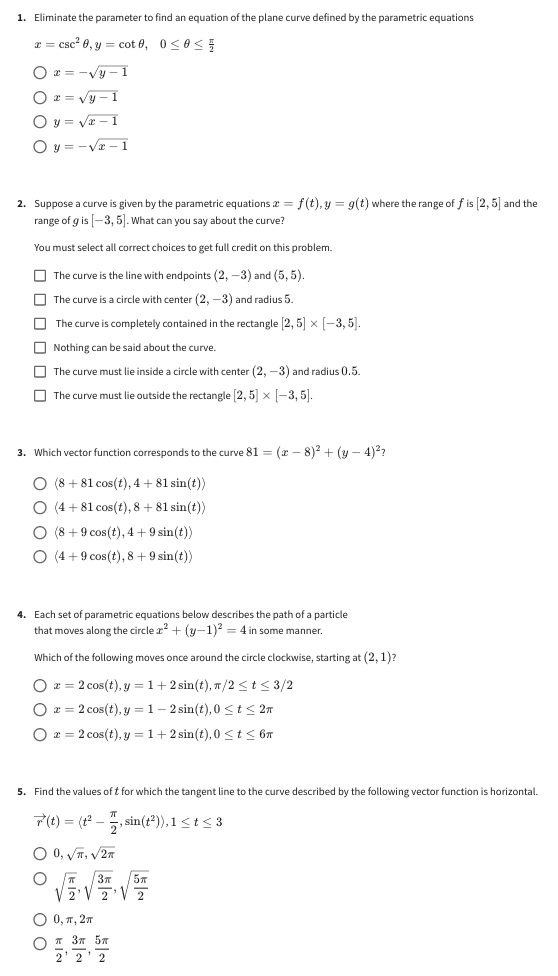

2-3
If writing process is bothering you,
it's ok to write only correct answer in each question.
" Let (t) = (3t2 + 5) i + (4cost) j' Find / (t) dt. None of these O (t) + 5t + C1, 4sint + C2) Oth + 5t + 4 sint O (t) + 5t, 4 sint) O + + 5t + 4 sint + C 7. If the initial and terminal point of a parametrizationen it is called a closed curve. Which of the following vector functions parametrizationed curve? O (5 sint, t' ), -RStux O (et , et ), - 25ts2 O (2 cost, t - cost), 0 S t s 2n O (et cost, et sint), 0 S t s 2x 8. Find the domain of the vector function ?() = (v9 -t, In(# + 1) - t, #-3). O (-1, 9] O (-00, 0) U (0, 00) O (-1,0) O [-1,9] O (-1,0) U (0, 9] 9. Consider the curve O parametrizationuations x = et, y = tel, 2 = tet. Find a parametrization of the tangent line to O at the point (1, 0, 0). O L(t) = (1 + t, t, t) O L(t) = (1 + t, 0, 0) O L(t) = (1 + t, 2t, 3t) O L(t) = (t, t, t) 10. Let 7 (t ) = (-20 ) 7' + (13 ) 3 + (3+5 + 1 ) 7. Find / v (t) dt. Enter your answer as a combination of the basis vectors ? , j', K . For example, (1, 2, 3) would be entered as 1*i+2*j+3*k Preview will appear here... Enter math expression here1. Eliminate the parameter to find an equation of the plane curve defined by the parametric equations * = csc- 0, y = cote, OS85 ; Of= -vy -1 Or = vy-I Oy = vr -I Oy= -vr -1 2. Suppose a curve is given by the parametric equations a = f (t), y = g(t) where the range of f is [2, 5] and the range of g is [-3, 5]. What can you say about the curve? You must select all correct choices to get full credit on this problem. The curve is the line with endpoints (2, -3) and (5, 5). The curve is a circle with center (2, -3) and radius 5. The curve is completely contained in the rectangle [2, 5] x [-3, 5]. Nothing can be said about the curve. The curve must lie inside a circle with center (2, -3) and radius 0.5. The curve must lie outside the rectangle [2, 5] x [-3, 5]. 3. Which vector function corresponds to the curve 81 = (x - 8) + (y - 4)?? O (8 + 81 cos(t), 4 + 81 sin(t)) O (4 + 81 cos(t), 8 + 81 sin(t) ) O (8 + 9 cos(t), 4 + 9 sin(t)) O (4 + 9 cos(t), 8 + 9 sin(t) ) 4. Each set of parametric equations below describes the path of a particle that moves along the circle e' + (y-1) = 4 in some manner. Which of the following moves once around the circle clockwise, starting at (2, 1)? O x = 2 cos(t), y = 1+ 2sin(t), w/2 t










